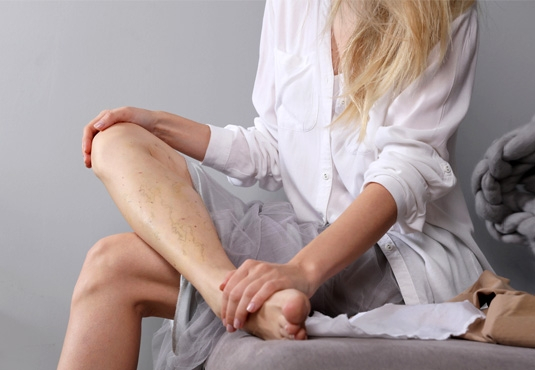
Varicose veins refer to the visible condition where the veins underneath the skin become enlarged and twisted due to the expansion of the superficial veins.
It is commonly observed in the leg veins, where the return of blood to the heart is most challenging (against the force of gravity),leading to significant enlargement and a twisted appearance of the normal veins in the legs due to inadequate valve function.
Varicose veins in the legs are a form of venous disease and are observed in about one in every five or six individuals in the population.
Initially causing discomfort in terms of appearance, varicose veins can progress to symptoms such as pain, swelling, and cramps. Patients most commonly complain of a feeling of heaviness in the legs and swelling in the legs towards the end of the day. The formation of clots in the dilated veins can lead to a condition called thrombophlebitis, which presents with pain, swelling, and redness. This can significantly hinder the patient's daily activities.
The formation of varicose veins can be influenced by factors such as pregnancy, obesity, prolonged standing, the use of birth control pills, constipation, aging, and genetic factors. Especially in some individuals after pregnancy, the development of varicose veins on the inner sides of the thighs is observed.
Visible varicose veins are a consequence, and the main cause is the insufficiency of the valves in the veins. Due to this insufficiency, blood that should go upward flows downward and pools, leading to increased pressure and swelling in the veins. In these patients, symptoms such as blue-green swelling, pain, swelling, numbness, and itching in the legs occur. Thus, both aesthetic concerns and an increase in symptoms are observed.
While varicose veins may initially be perceived as merely a cosmetic problem, they can actually disrupt the quality of life by causing symptoms such as pain, burning, cramps, fatigue, and swelling in the ankles. Advanced and enlarged varicose veins can clot, bleed, or create wounds on the ankles. Complaints about varicose veins are often expressed by female patients for aesthetic reasons.
Although the exact cause is not fully understood, it is known to have a hereditary component and is more commonly observed in females and individuals with jobs that involve prolonged standing.
Varicose veins are classified into spider veins, which result in a spiderweb-like appearance, reticular veins affecting slightly larger veins, and larger varicose veins involving major veins.
Spider veins are commonly observed in young women, often associated with pregnancy and hormone use. Reticular veins are bluish-green veins seen around the knee and ankle areas. Major varicose veins develop due to valve insufficiency in superficial anatomical veins, causing them to protrude from the skin and manifest varicose symptoms. While spider veins are more of an aesthetic concern, larger varicose veins can lead to health issues.
In the treatment of varicose veins, when problematic valves cannot be corrected, it is necessary to eliminate the superficial veins causing varicose formation. In the treatment, these diseased veins are either surgically removed or rendered non-functional within the body. This ensures the correction of the proper flow of blood from the affected system to the heart.
Varicose vein treatment involves the removal of the insufficient vein. However, the traditional open surgical method has given way to modern techniques such as laser treatment, radiofrequency ablation, and vein closure. It is generally performed as a day surgery procedure and can be administered with local or sedation anesthesia. Thanks to this method, patients can quickly return to their social lives. The procedure is considered comfortable and brief from the patient's perspective.
In recent years, advanced non-surgical methods for varicose vein treatment (such as laser ablation, radiofrequency ablation, steam ablation, sclerotherapy, etc.) are primarily based on rendering the vein non-functional within the body (endovenous varicose vein treatment methods). Laser or radiofrequency ablation is commonly preferred, and the procedure typically takes about 30-45 minutes for a single leg.
Non-surgical varicose vein treatment is performed under the guidance of ultrasound and local anesthesia, ensuring a completely painless experience without leaving any surgical scars on the leg. There is no need for the treated person to stay in the hospital or at home after the procedure; they are encouraged to walk immediately after treatment and are discharged soon after.
After non-surgical varicose vein treatment, patients are usually advised to wear compression stockings for approximately 2-3 weeks and return for a follow-up examination on the 30th day.
When the varicose vein treatment is performed by experienced individuals using ultrasound and endovenous methods, there are typically no significant side effects. However, in cases of insufficient experience with ultrasound and endovenous treatment, complications such as blockage in deep veins and pulmonary embolism have been reported. It is crucial for these procedures to be conducted by experienced teams.
To prevent the development of varicose veins, regular exercise, weight loss, avoiding prolonged standing or sitting, staying away from tight clothing, choosing flat shoes instead of high heels, and avoiding situations that require straining (such as constipation) can help prevent varicose vein formation. The simplest practice that can be done is regular walking.
We are committed to being with you during your treatment process for general surgery diseases with accurate diagnosis and effective treatment methods. Here, you can read the real experiences of my patients who share their health journey with me. Their sincere comments can be a guide for you as well.